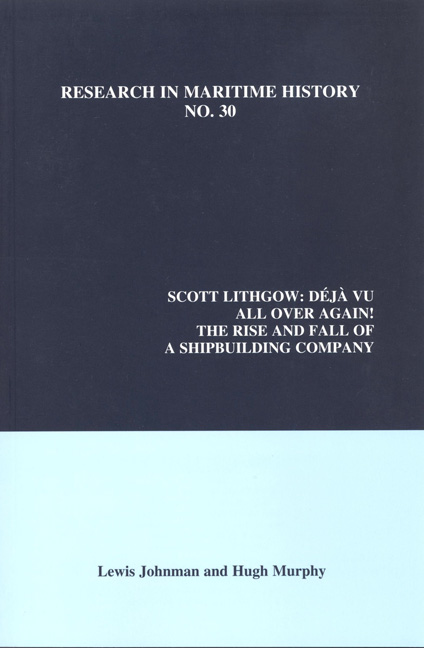Book contents
- Frontmatter
- Contents
- Acknowledgement
- Introduction
- Chapter 1 Scotts of Greenock, 1711-1945
- Chapter 2 Russell and Company to Lithgows Limited, 1874-1945
- Chapter 3 Scotts Shipbuilding and Engineering, 1945-1965
- Chapter 4 Lithgows Limited, 1945-1965
- Chapter 5 The Long March to Merger, 1965-1970
- Chapter 6 The Road to Nationalisation, 1970-1977
- Chapter 7 Nationalisation to Privatisation, 1977-1984
- Chapter 8 Déjà vu All over Again: Trafalgar House, 1984-1988
- Chapter 9 Conclusion
- Appendix
- Bibliography
Chapter 4 - Lithgows Limited, 1945-1965
- Frontmatter
- Contents
- Acknowledgement
- Introduction
- Chapter 1 Scotts of Greenock, 1711-1945
- Chapter 2 Russell and Company to Lithgows Limited, 1874-1945
- Chapter 3 Scotts Shipbuilding and Engineering, 1945-1965
- Chapter 4 Lithgows Limited, 1945-1965
- Chapter 5 The Long March to Merger, 1965-1970
- Chapter 6 The Road to Nationalisation, 1970-1977
- Chapter 7 Nationalisation to Privatisation, 1977-1984
- Chapter 8 Déjà vu All over Again: Trafalgar House, 1984-1988
- Chapter 9 Conclusion
- Appendix
- Bibliography
Summary
Lithgows’ contribution to the war effort through its Port Glasgow yards and its subsidiary shipbuilding, marine engine-building and heavy engineering companies was immense. In shipbuilding alone, taking the entirely naval Fairfield output measured in standard displacement tons and somewhat artificially converting it by a factor of three to gross tons, the claimed combined output of the Lithgow Kingston and East shipyards and the Fairfield facility amounted to over 800,000 gross tons. Throughout the war, Sir James Lithgow had been indefatigable in his role as Controller of Merchant Shipbuilding and Repair at the Admiralty and for a short period had also been Controller of Tanks. In the national interest he had remained chairman of Beardmore, and later in the war he resumed the chair at Fairfield. At Beardmore he had continued his tried and trusted policy of building up substantial reserves, but Fairfield was in many respects a more difficult task. For his part, Henry Lithgow, with the aid of John Muirhead, who retired in 1946 as Lithgows’ managing director, tirelessly supervised war production at the East and Kingston yards and oversaw production at the many Lithgow subsidiaries. Lithgows’ war output was not, however, complicated by naval work, and concentration on volume tramp ship construction led to sustained profitability. With the likelihood of a postwar boom in mercantile construction ahead, the future of the firm seemed assured.
The immediate postwar history of the Port Glasgow firm was to be dominated by the death of Henry Lithgow on 23 May 1948 at the age of sixtyone and by the failing health of Sir James, who had suffered a thrombosis later the same year from which he did not fully recover. Before his death in February 1952, however, Sir James Lithgow had realised many of his previous investments, and the remaining family holdings in William Beardmore and Colvilles were sold at a considerable profit. The proceeds of these sales were split between a number of family trusts (in Sir James’ case, by way of a deed of provision in 1937 and again in 1946) to benefit his two daughters, Margaret and Ann, and his son, William. These arrangements and the complexities consequent upon them gave the Lithgow enterprise a dual character for much of the postwar period.
- Type
- Chapter
- Information
- Scott LithgowDéjà Vu all over again! The Rise and Fall of a Shipbuilding Company, pp. 117 - 156Publisher: Liverpool University PressPrint publication year: 2005



